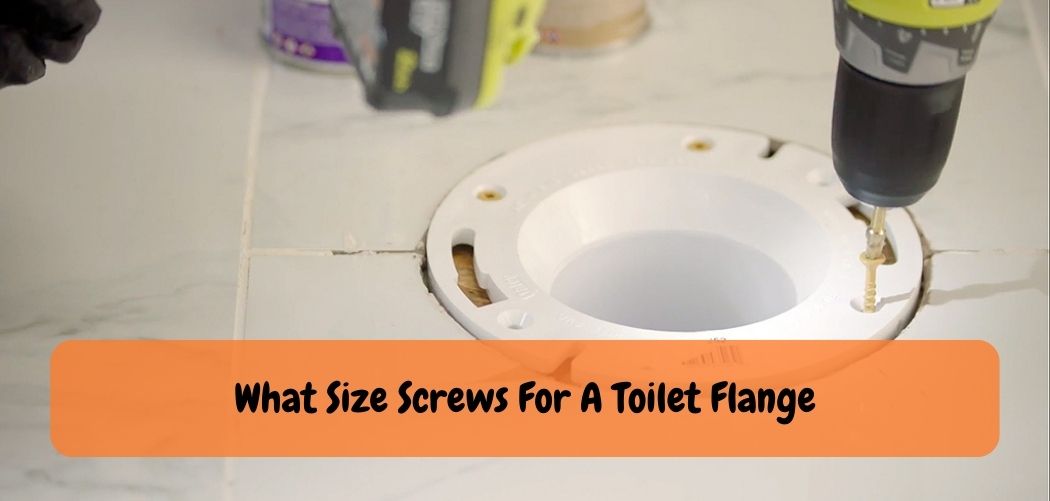The size of screws for a toilet flange can vary based on the flange type and bathroom floor material. However, a common size for toilet flange screws is #10 or #12 screws that are typically 2.5 to 3 inches in length.
Here are some general guidelines:
- Size: #10 or #12 screws are typically suitable for securing a toilet flange. These screw sizes provide good stability.
- Length: The length of the screws should be long enough to penetrate through the flooring material (usually plywood or concrete) and securely anchor the flange to the floor below. A length of 2.5 to 3 inches is generally sufficient for most installations.
- Material: It’s a good idea to use corrosion-resistant screws to prevent rust over time, especially if your bathroom is prone to moisture. Stainless steel screws are an excellent choice for this purpose.
- Type: You can use either wood screws or concrete screws, depending on your subfloor material. For wood subfloors, use wood screws. For concrete subfloors, use concrete screws with appropriate anchors.
- Quantity: You’ll typically need at least four screws to secure the flange in place. Some flanges have more screw holes for added stability. Refer to the specific flange’s instructions for guidance on the number of screws needed.
Always follow the manufacturer's instructions for the specific toilet flange you are installing. As there may be variations in design and recommendations. Make sure to tighten the screws just right - not too loose or too tight. This could harm the flange or floor. If you don't know what screws to use, ask a plumber or contractor for help. They can guide you, especially if you're not familiar with plumbing.
Important Info Related to Using Toilet Flange
Securing a toilet flange is a crucial step in any bathroom renovation or plumbing project. Using the right screws and knowing how many to use can make the difference between a sturdy, leak-free toilet and a potential disaster waiting to happen. In this guide, we will answer common questions about toilet flange screws, including what size screws to use, how many you need, and whether a toilet flange should be screwed at all.
Types of Screws for Toilet Flange
To start, let’s understand the various screws used to secure a toilet flange. The choice of screw type can impact the longevity and stability of your installation. Here are a few options:
- Wood Screws: These are suitable for wooden subfloors and flanges, providing a secure hold.
- Self-Tapping Screws: Ideal for securing a toilet flange to concrete or tile floors, as they create their own threads.
- Stainless Steel Screws: Highly corrosion-resistant, making them a great choice for long-lasting installations.
How Many Screws Do I Need to Secure a Toilet Flange?
The number of screws you need to secure a toilet flange. It’s typically depends on the design of the flange and the manufacturer’s recommendations. However, a common configuration is to use four screws to secure a toilet flange properly.
Here’s how the screws are typically placed:
- Two screws on one side: You’ll usually find two screw holes on one side of the toilet flange. These two screws are positioned diagonally from each other.
- Two screws on the other side: Similarly, there are two more screw holes on the opposite side of the flange, also positioned diagonally from each other.
By using four screws in this manner, you ensure that the flange is securely anchored to the floor. The screws are placed diagonally to evenly distribute the load and provide stability.
However, some toilet flanges may have additional screw holes or slots for screws to provide extra stability, especially for larger or heavier toilets. Always refer to the installation instructions provided with your specific toilet flange for the manufacturer’s recommended screw placement and quantity.
When you install a toilet flange, make sure to use the right size and type of screws for your subfloor. It could be wood or concrete. For prevent rust, consider using corrosion-resistant screws, such as stainless steel. Make sure the toilet and waste pipe connect well, it’s important to secure the flange properly. This will prevent leaks and keep everything stable.
Should Toilet Flange Be Screwed?
Yes, a toilet flange should screwed securely to the floor. The screws are use to anchor the flange to the bathroom floor, and this is an essential step in the installation process for several reasons:
- Stability: Securing the toilet flange with screws ensures that it remains stable and stationary. The flange is important because it holds the toilet in place. If the flange moves or is unstable, it can cause leaks or damage.
- Sealing: The wax ring or other sealing material that creates a watertight seal between the toilet and the waste pipe needs a stable surface to work effectively. If the flange is not firmly attached to the floor, it can shift and cause leaks.
- Prevention of Leaks: A properly secured flange helps prevent leaks by keeping the toilet in place and maintaining a tight seal between the toilet and the waste pipe. This is crucial for preventing sewage gases and wastewater from escaping into the bathroom.
- Weight Distribution: Toilets can be heavy, and the screws used to secure the flange help distribute the weight of the toilet evenly across the flange and the floor beneath it. This prevents stress on the flange and minimizes the risk of it cracking or breaking under the weight of the toilet.
When securing a toilet flange to the floor, use the appropriate size and type of screws for your subfloor material (wood or concrete), and follow the manufacturer's installation instructions for your specific flange. It's essential to tighten the screws snugly but not over-tighten, as over-tightening can potentially damage the flange or the floor. Properly securing the toilet flange is a critical step in ensuring a leak-free and stable toilet installation.
Toilet Flange Installation Tips
For a successful toilet flange installation, follow these steps:
- Position the flange over the waste pipe and align it with the floor’s drain hole.
- Mark the locations for your screws, ensuring they’re evenly spaced.
- Pre-drill holes for the screws to prevent splitting of the flooring.
- Secure the flange in place using the appropriate screws and a screwdriver or drill.
- Double-check the stability and levelness of the flange before proceeding to install the toilet.
Toilet Flange Maintenance and Troubleshooting
It’s important to maintain and troubleshoot your toilet flange to prevent leaks and other problems. Here are some tips for maintaining and troubleshooting a toilet flange:
Maintenance:
- Regular Cleaning: Keep the area around the toilet flange clean. Dirt and debris can accumulate over time, which can lead to sealing problems and odors. Regularly clean the area with a mild detergent and water.
- Inspect for Cracks: Periodically inspect the toilet flange for any cracks or damage. Cracks can compromise the flange’s integrity and lead to leaks. If you notice any cracks, consider replacing the flange.
- Tighten Screws: Check the screws that secure the flange to the floor. Over time, they may become loose. If you notice any wobbling or movement of the toilet, tighten the screws carefully to secure the flange in place.
- Wax Ring Replacement: The wax ring between the toilet and the flange can degrade over time. If you notice any leaks or rocking of the toilet, it may be time to replace the wax ring. This involves removing the toilet, replacing the wax ring, and reseating the toilet.
Troubleshooting:
- Leaking: If you notice water around the base of the toilet, it could be a sign of a leak at the flange. Check for any cracks or damage to the flange itself. Also, make sure the wax ring is properly sealed. If necessary, replace the wax ring or repair the flange.
- Rocking Toilet: A toilet that rocks or moves when you sit on it could indicate a problem with the flange. Inspect the screws holding the flange to the floor. If they are loose or damaged, tighten or replace them as needed.
- Odors: If you notice foul odors coming from around the base of the toilet, it could be due to a faulty seal between the toilet and the flange. In this case, you may need to replace the wax ring to create a proper seal.
- Cracked Flange: If the toilet flange is cracked, it should replace. A cracked flange can lead to leaks and instability in the toilet.
- Improper Height: If the flange is not at the correct height, it can cause problems with the toilet’s flush and sealing. In such cases, you may need to use flange extenders or shims to adjust the flange’s height.
- Damaged Subfloor: Sometimes, the subfloor beneath the flange can become damaged or rot over time. If you suspect this is the issue, you may need to repair or replace the subfloor before reinstalling the flange and toilet.
If you don't know how to fix plumbing problems or if you come across difficult issues, it's a good idea to hire a plumber. They can check the problem and fix it so your toilet works well and doesn't damage your home.
Conclusion
In the world of home improvement and plumbing, even the smallest details can have a big impact. It’s crucial to pick the correct size screws for your toilet flange. This ensures long-lasting stability.
We hope this guide helped you see the importance of choosing the right screw size for your toilet flange. It should have answered your questions about installing a bathroom. It is crucial. To prevent toilet problems, make sure the flange is secure and installed correctly.
Next time you renovate your bathroom or work on plumbing, think about the screw. When you make the right choice, you’re not just securing your toilet flange. You’re also ensuring a comfortable, convenient, and worry-free bathroom.
Additional Resources
- What to Do If Toilet Flange is Too Low?
- What Connects to the Toilet Flange?
- The Truth About Toilet Flange Positioning
- Toilet Flange on Concrete or Tile?
- Easy Guide: Installing Toilet Flanges Like a Pro
- What’s the Right Toilet Flange Size for Your Bathroom?
- Toilet Flange Installation: Before or After Flooring?

